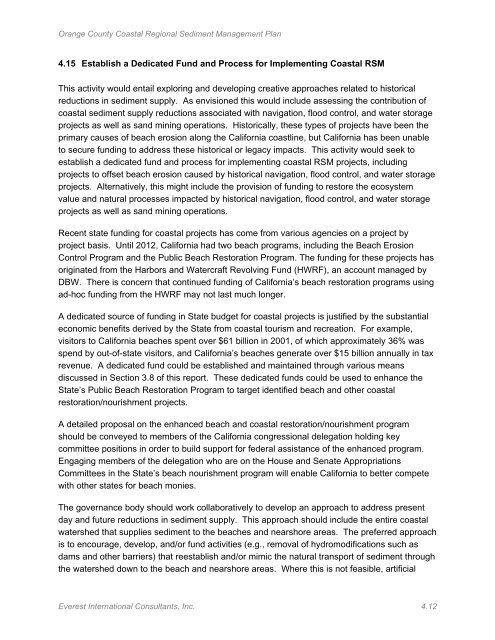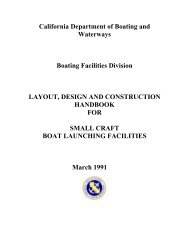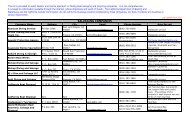EVEREST June, 2013 - California Department of Boating and ...
EVEREST June, 2013 - California Department of Boating and ...
EVEREST June, 2013 - California Department of Boating and ...
You also want an ePaper? Increase the reach of your titles
YUMPU automatically turns print PDFs into web optimized ePapers that Google loves.
Orange County Coastal Regional Sediment Management Plan<br />
4.15 Establish a Dedicated Fund <strong>and</strong> Process for Implementing Coastal RSM<br />
This activity would entail exploring <strong>and</strong> developing creative approaches related to historical<br />
reductions in sediment supply. As envisioned this would include assessing the contribution <strong>of</strong><br />
coastal sediment supply reductions associated with navigation, flood control, <strong>and</strong> water storage<br />
projects as well as s<strong>and</strong> mining operations. Historically, these types <strong>of</strong> projects have been the<br />
primary causes <strong>of</strong> beach erosion along the <strong>California</strong> coastline, but <strong>California</strong> has been unable<br />
to secure funding to address these historical or legacy impacts. This activity would seek to<br />
establish a dedicated fund <strong>and</strong> process for implementing coastal RSM projects, including<br />
projects to <strong>of</strong>fset beach erosion caused by historical navigation, flood control, <strong>and</strong> water storage<br />
projects. Alternatively, this might include the provision <strong>of</strong> funding to restore the ecosystem<br />
value <strong>and</strong> natural processes impacted by historical navigation, flood control, <strong>and</strong> water storage<br />
projects as well as s<strong>and</strong> mining operations.<br />
Recent state funding for coastal projects has come from various agencies on a project by<br />
project basis. Until 2012, <strong>California</strong> had two beach programs, including the Beach Erosion<br />
Control Program <strong>and</strong> the Public Beach Restoration Program. The funding for these projects has<br />
originated from the Harbors <strong>and</strong> Watercraft Revolving Fund (HWRF), an account managed by<br />
DBW. There is concern that continued funding <strong>of</strong> <strong>California</strong>’s beach restoration programs using<br />
ad-hoc funding from the HWRF may not last much longer.<br />
A dedicated source <strong>of</strong> funding in State budget for coastal projects is justified by the substantial<br />
economic benefits derived by the State from coastal tourism <strong>and</strong> recreation. For example,<br />
visitors to <strong>California</strong> beaches spent over $61 billion in 2001, <strong>of</strong> which approximately 36% was<br />
spend by out-<strong>of</strong>-state visitors, <strong>and</strong> <strong>California</strong>’s beaches generate over $15 billion annually in tax<br />
revenue. A dedicated fund could be established <strong>and</strong> maintained through various means<br />
discussed in Section 3.8 <strong>of</strong> this report. These dedicated funds could be used to enhance the<br />
State’s Public Beach Restoration Program to target identified beach <strong>and</strong> other coastal<br />
restoration/nourishment projects.<br />
A detailed proposal on the enhanced beach <strong>and</strong> coastal restoration/nourishment program<br />
should be conveyed to members <strong>of</strong> the <strong>California</strong> congressional delegation holding key<br />
committee positions in order to build support for federal assistance <strong>of</strong> the enhanced program.<br />
Engaging members <strong>of</strong> the delegation who are on the House <strong>and</strong> Senate Appropriations<br />
Committees in the State’s beach nourishment program will enable <strong>California</strong> to better compete<br />
with other states for beach monies.<br />
The governance body should work collaboratively to develop an approach to address present<br />
day <strong>and</strong> future reductions in sediment supply. This approach should include the entire coastal<br />
watershed that supplies sediment to the beaches <strong>and</strong> nearshore areas. The preferred approach<br />
is to encourage, develop, <strong>and</strong>/or fund activities (e.g., removal <strong>of</strong> hydromodifications such as<br />
dams <strong>and</strong> other barriers) that reestablish <strong>and</strong>/or mimic the natural transport <strong>of</strong> sediment through<br />
the watershed down to the beach <strong>and</strong> nearshore areas. Where this is not feasible, artificial<br />
Everest International Consultants, Inc. 4.12




